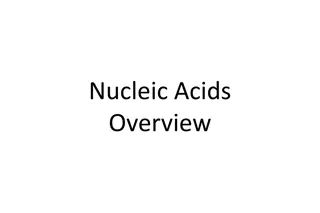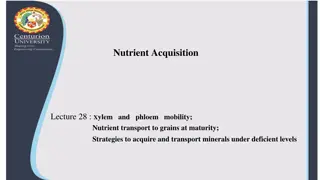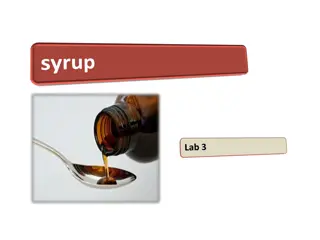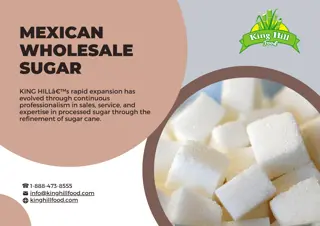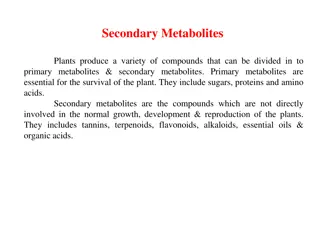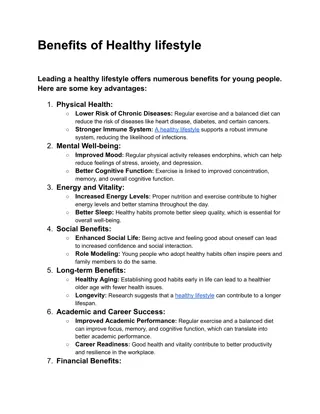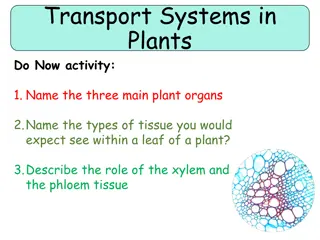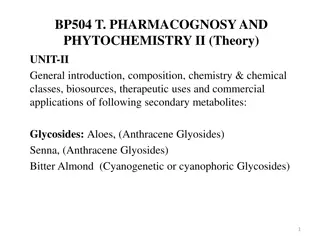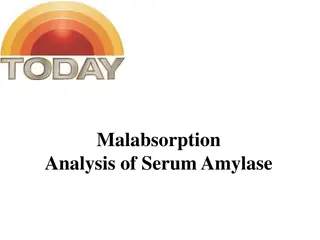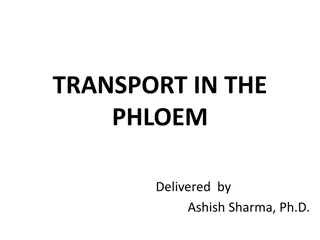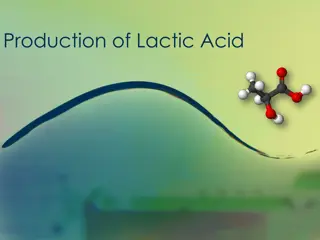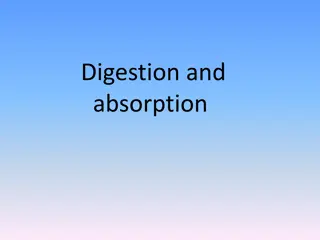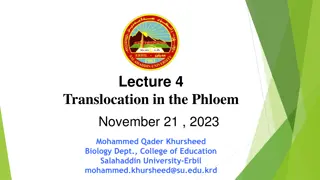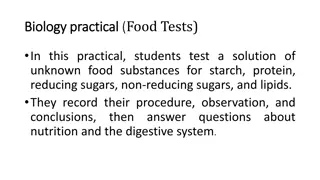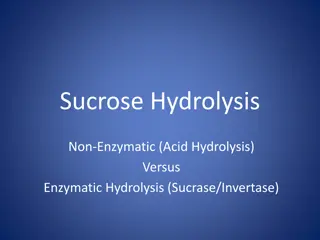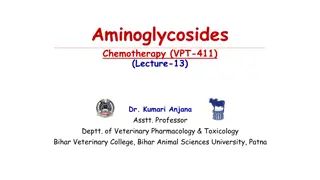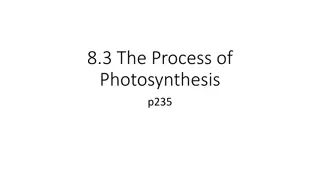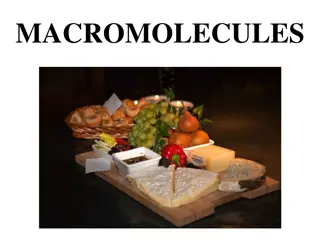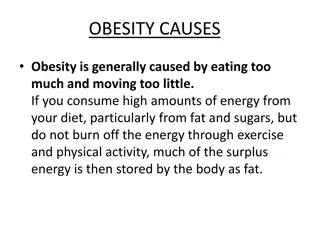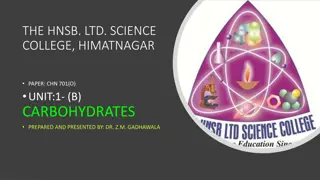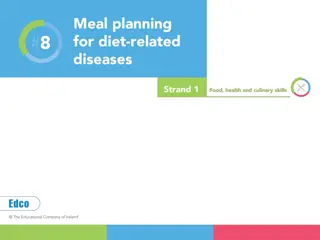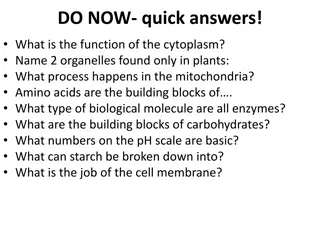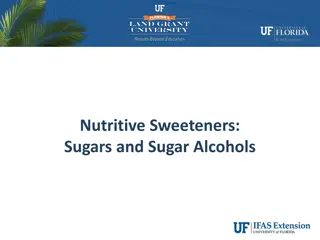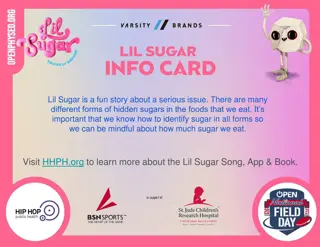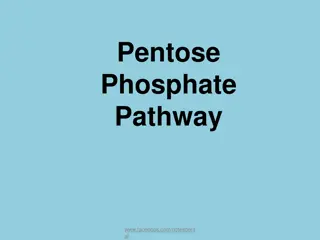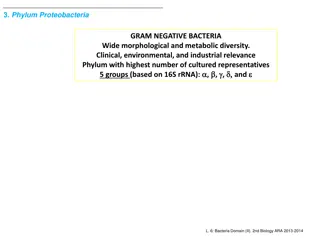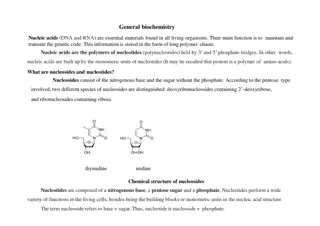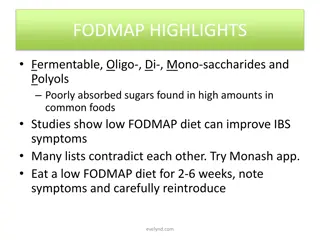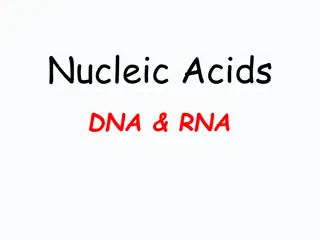Nucleic Acids Overview
Delve into the intricate world of nucleic acids with a focus on DNA and RNA structures, DNA replication, RNA transcription, protein biosynthesis, cancer/chemotherapy, genetic engineering, and more. Explore the structures of bases, sugars, nucleosides, nucleotides, and parts of nucleotides, along wit
8 views • 58 slides
Understanding How Diabetes Affects Blood Vessels
Diabetes can harm blood vessels, leading to complications due to high blood sugar levels. Hemoglobin A1c plays a crucial role in monitoring glucose control, with values above 6.5% indicating diabetes. Over time, high blood sugars can damage blood vessels, affecting blood flow and increasing the risk
1 views • 19 slides
Nutrient Acquisition
Plants utilize xylem and phloem to transport water, nutrients, and minerals throughout their structures. Xylem moves water and mineral salts from roots to leaves, while phloem transports sugars and amino acids from leaves to the rest of the plant. Nutrient acquisition involves passive and active tra
2 views • 6 slides
Understanding Osazone Test: A Chemical Test for Detecting Reducing Sugars
The Osazone test is a chemical test used to detect reducing sugars by forming derivatives of carbohydrates with phenyl hydrazine. This test helps in distinguishing different reducing sugars and differentiating between reducing and non-reducing sugars. The principle involves the reaction between carb
11 views • 22 slides
Understanding Syrups: Types, Formulations, and Storage Considerations
Syrups are sweet, viscous liquids used in pharmaceutical preparations. They can be non-medicated for flavoring or medicated for therapeutic purposes. There are sugar-based and sugar-free syrups, with sucrose preferred for its purity and handling ease. Preservatives like benzoate and sorbic acid are
4 views • 16 slides
Reagent Preparation for Food Analysis: Barfoed's and Seliwanoff's Tests
Preparation of reagents such as Barfoed's reagent and Seliwanoff's reagent is essential for detecting monosaccharides in food analysis. Barfoed's test utilizes a mixture of acetic acid and copper(II) acetate to detect reducing sugars, while Seliwanoff's reagent helps identify ketoses in solutions. U
2 views • 19 slides
King Hill Foods LLC: Your Premier Wholesale Sugar Supplier
At King Hill Foods LLC, we pride ourselves on being a leading wholesale supplier of high-quality sugars, dedicated to meeting the diverse needs of our clients. With a commitment to excellence and customer satisfaction, we offer a wide range of sugar products tailored to various industries, including
3 views • 4 slides
Understanding Plant Metabolites: Primary vs. Secondary & Their Biological Functions
Primary metabolites are crucial for plant survival, including sugars and amino acids, while secondary metabolites, like tannins, terpenoids, and flavonoids, play diverse roles such as protection from pathogens, pigmentation, and health benefits. Tannins offer antiviral and antibacterial effects, ter
1 views • 7 slides
Thriving Through Wellness: Your Path to a Healthy Lifestyle" "Living Well: Essen
A healthy lifestyle for young adults is essential for overall well-being and long-term health. It involves eating a balanced diet rich in fruits, vegetables, whole grains, and lean proteins, while limiting processed foods and sugars. Regular exercise
0 views • 2 slides
Understanding Plant Transport Systems: Organs, Tissues, and Functions
Explore the key components of plant transport systems including organs, tissues, and the roles of xylem and phloem in transporting water, sugars, and minerals essential for plant life. Engage in activities, assessments, and a video to deepen your understanding.
0 views • 14 slides
Understanding Anthracene Glycosides in Pharmacognosy and Phytochemistry
Anthracene glycosides are secondary metabolites found in various plant families, offering therapeutic benefits. This comprehensive study explores their composition, chemistry, biosources, and applications, detailing the structural variations of aglycones and sugars present in these compounds. Method
0 views • 30 slides
Understanding Sensory Attributes of Ice Cream and Frozen Desserts in Dairy Technology
Ice cream and frozen desserts are formulated with dairy products, sugars, flavorings, and stabilizers. Various types are available, each with unique characteristics like flavor, body, texture, and melting quality. High-quality ice cream should possess a balanced flavor, desirable body, and smooth me
0 views • 13 slides
The Digestive Journey: From Skittles in the Mouth to Nutrient Absorption in the Intestine
The process begins with chewing skittles in the mouth, where salivary amylase breaks down sugar. The bolus then travels down the esophagus via peristalsis into the stomach, further broken down by gastric juice. The pancreas releases enzymes like amylase and lipase to digest sugars and fats. Bile pro
2 views • 15 slides
Exploring Healthy Beverage Choices and Sugar Content
This educational session delves into the health implications of fizzy drinks versus water, highlighting the sugar content in popular beverages like Lucozade and Mountain Dew. Participants engage in activities to understand recommended sugar intake, analyze labels for hidden sugars, and categorize dr
1 views • 14 slides
Understanding Amylase: Sources, Functions, and Clinical Significance
Amylase is an essential enzyme found in saliva, pancreatic juice, and plants that aids in the breakdown of starch into sugars. This article explores the sources, physiological actions, and diagnostic uses of amylase in clinical practice, focusing on conditions such as acute pancreatitis. It also del
0 views • 22 slides
Transport in the Phloem: A Detailed Overview by Ashish Sharma, Ph.D.
The phloem plays a vital role in transporting sugars and organic materials throughout plants. This system involves various specialized cells like sieve elements, companion cells, parenchyma cells, and phloem fibers. Mature sieve elements lack certain organelles and have non-lignified cell walls, mak
7 views • 32 slides
Overview of Lactic Acid Production and Applications
Lactic acid occurs in two isomeric forms and has various applications in food, pharmaceuticals, and skincare industries. It is primarily produced through the fermentation of sugars by microorganisms. The production process involves using raw materials like purified sugars and agricultural wastes. Th
4 views • 11 slides
Understanding Carbohydrate Digestion and Absorption
Carbohydrate digestion begins in the mouth with the release of salivary amylase, continues in the stomach where chyme is formed, and is completed in the small intestine with the help of pancreatic enzymes. Absorption of the broken-down sugars occurs in the small intestine, while undigested carbohydr
2 views • 32 slides
Understanding Translocation in the Phloem
This lecture explores the process of translocation in the phloem, supported by evidence from studies such as aphid experiments, ringing experiments, and the use of radioactive isotopes. It delves into the materials translocated in phloem sap, including water, sucrose, non-reducing sugars, nitrogen c
5 views • 18 slides
Food Tests in Biology Practical
In this biology practical, students test a solution of unknown food substances for starch, protein, reducing sugars, non-reducing sugars, and lipids. They conduct various tests, record observations, and draw conclusions. The preparation of chemical solutions such as Benedict's solution, copper sulfa
0 views • 45 slides
Understanding the Calvin Cycle in Photosynthesis
The Calvin cycle, also known as the light-independent reactions, is a crucial part of photosynthesis where carbon dioxide is converted into glucose. This cycle occurs in the stroma of chloroplasts and utilizes ATP and NADPH from the light-dependent reactions to produce sugars for plants. It consists
5 views • 15 slides
Understanding Sucrose Hydrolysis and Reducing Sugars in Carbohydrate Chemistry
This content delves into the mechanisms of sucrose hydrolysis through non-enzymatic and enzymatic processes, highlighting disaccharides like sucrose, lactose, and maltose. It explores the significance of glycosidic bonds in carbohydrate structures and discusses the reducing capacity of sugars such a
7 views • 16 slides
Understanding Aminoglycosides in Veterinary Pharmacology
Aminoglycosides are a crucial group of antibiotics in veterinary medicine, known for their bactericidal properties and shared chemical characteristics. This class of drugs has a rich history, with members like streptomycin, neomycin, kanamycin, gentamicin, and amikacin. Chemistry-wise, aminoglycosid
0 views • 40 slides
Understanding Photosynthesis and Its Processes
Photosynthesis is a crucial process where plants use sunlight to produce energy in the form of ATP and NADPH through light-dependent reactions, leading to the creation of sugars in the light-independent reactions. Factors such as temperature, light, and water play essential roles in regulating photo
0 views • 8 slides
Obesity Trends and Food Environment Changes in the United States
The presentation highlights the obesity epidemic among U.S. adults and children, showing the increase in overweight and obese individuals over the years. It also discusses the rise in daily calorie availability and the percentage increase in calorie intake from different food categories. Furthermore
1 views • 11 slides
Understanding Macromolecules and Energy from Food
Explore the world of macromolecules, including carbohydrates, lipids, proteins, and nucleic acids, and learn how these large molecules are formed from smaller units. Discover the role of carbohydrates in providing energy, digestion, and absorption, and delve into the different types of carbohydrates
0 views • 9 slides
Understanding Obesity: Causes and Factors Contributing to Weight Gain
Obesity is typically a result of consuming excess energy from a diet rich in fat and sugars while not expending that energy through physical activity. Factors like poor diet choices, lack of exercise, and genetic traits can contribute to the development of obesity over time. Environmental influences
0 views • 5 slides
Quality Education for a Healthier Scotland - Smile4life Initiatives and Oral Health Awareness
Explore Smile4life's programs focused on promoting oral health across Scotland. Learn about giving health advice, understanding the importance of oral health, and combating tooth decay through education. Discover key messages on diet, hidden sugars, and tooth decay prevention. Dive into the findings
0 views • 30 slides
Understanding Carbohydrates in Science: Structure, Types, and Applications
Explore the comprehensive study of carbohydrates, including their types such as monosaccharides, disaccharides, and polysaccharides. Learn about the molecular structure and functions of cellulose, starch, and other key carbohydrates. Delve into the chemistry of sugars, nucleic acids, and protein syn
0 views • 32 slides
Healthy Eating Guidelines for Common Health Conditions
Planning meals for individuals with cardiovascular disease, dental disease, diabetes, and obesity involves choosing the right foods from each food group, using healthy cooking methods, and avoiding excessive fats and sugars. For cardiovascular and dental health, emphasizing low-fat options, avoiding
0 views • 14 slides
Cellular Processes and Functions Explained
The cytoplasm is essential for cell function, housing organelles like chloroplasts and vacuoles unique to plants. Mitochondria facilitate cellular respiration, while amino acids form proteins. Enzymes are proteins, and carbohydrates consist of simple sugars. Basic pH numbers range from 8 to 14. Star
0 views • 24 slides
Understanding Nutritive Sweeteners and Added Sugars in the American Diet
Americans consume high amounts of added sugars daily, with teenagers accounting for a significant portion. Sugar intake has significantly increased over the years, leading to concerns about health implications. Various organizations recommend limiting added sugar intake to maintain overall health, e
1 views • 27 slides
Fun Activities and Challenges with Lil Sugar for Health Awareness
Lil Sugar is a fun story addressing hidden sugars in food. Engage in entertaining activities like costume races, plank station adventures, and calorie-burning challenges set to the Lil Sugar song. Learn about identifying sugar forms and promote mindfulness in sugar consumption through interactive ga
0 views • 9 slides
Understanding Reducing Properties in Sugars
Reducing properties in sugars are a key concept in chemistry, especially in testing for the presence of aldehydic or ketonic groups. The experiment explores tests like Benedict's and Barfoed's, as well as the principles behind how reducing sugars interact with cupric hydroxide. Monosaccharides are h
0 views • 17 slides
Understanding the Pentose Phosphate Pathway in Metabolism
The Pentose Phosphate Pathway, also known as the Hexose Monophosphate shunt, is an alternative route for glucose metabolism that plays a crucial role in NADPH synthesis, fatty acid production, antioxidant activity, and nucleotide formation. This pathway involves oxidative and non-oxidative phases, r
0 views • 12 slides
Understanding Photosynthesis: Energy Conversion in Living Organisms
Explore the process of photosynthesis and how energy is harnessed by living organisms through the conversion of sunlight into high-energy sugars. Discover the essential role of ATP in cellular processes and learn about key scientists who contributed to our understanding of photosynthesis. Delve into
0 views • 22 slides
Exploring the Diverse World of Proteobacteria
Proteobacteria, a phylum of Gram-negative bacteria, exhibit wide morphological and metabolic diversity with clinical, environmental, and industrial relevance. This phylum, boasting the highest number of cultured representatives, is divided into various groups based on 16S rRNA sequencing. From N2-fi
0 views • 49 slides
Understanding Nucleic Acids: DNA, RNA, and Nucleotides
Nucleic acids, essential for all organisms, store genetic information as long polymer chains of nucleotides. Nucleosides contain bases and sugars, while nucleotides include a phosphate. Purines and pyrimidines are the aromatic bases in nucleotides, with DNA having A, G, C, T and RNA having A, G, C,
0 views • 10 slides
Understanding Low FODMAP Diet and Other Dietary Factors for Gut Health
Low FODMAP diet is a potential solution for managing IBS symptoms by avoiding poorly absorbed sugars. This diet involves eliminating certain carbohydrates found in common foods. Additionally, other factors like stress, gluten/dairy elimination, and various food compounds can impact gut health. Consi
0 views • 6 slides
Understanding Nucleic Acids: DNA and RNA Overview
Nucleic acids, including DNA and RNA, are essential molecules storing genetic information for cellular functions. Comprised of nucleotides with nitrogenous bases, sugars, and phosphate groups, they play crucial roles in intracellular signaling, energy transfer, and genetic makeup determination. Ribo
0 views • 26 slides
